Day 3 of a 3 day long weekend of tours today, and our last day. It was a windy day, rather blustery in the morning, but at least it was forecast to stay dry.
Our first stop was at Snettisham. We were not here for the Wader Spectacular today – it would have required a much earlier start to the day. But with the timing of high tide, we thought we could still get there in time to see a good number of waders gathered on the pits.
With the blustery SW wind, it looked like the water had not come right in to cover the last of the mud this morning, and there was still as large huddle of waders over in the far corner. A long smear of blacks and greys resolved itself into a mass birds through the scope – thousands of Oystercatchers, Curlew, Knot and Bar-tailed Godwits – roosting over high tide on the last remaining patch of uncovered mud.
 Waders – the huge flock huddled into the corner of the Wash
Waders – the huge flock huddled into the corner of the Wash
The tide was already starting to go out again and flocks of Sanderlings were flying in over the water to the mud. As we walked up to the hide, the first lines of Dunlin were already heading back out to the Wash from the pit.
The hide provided some welcome shelter from the wind and the chance to have a good look at the birds. Thankfully, there was still lots to see on the pit. The different species were segregated somewhat into different roosts on different islands and banks. Most of the Black-tailed Godwits were on the islands in front of the hide. There were a couple of massed flocks of Knot on the islands over to one side, with more godwits mixed in with them. Most were Black-tailed, but a closer look revealed a few Bar-tailed Godwits too. A couple of them were still in summer plumage, with rusty orange underparts extending right down under the tail.
The Dunlin were scattered around the edges or on the bits of the islands not filled with Knot. A Curlew Sandpiper had been seen before we arrived but had disappeared. We thought it might have flown off back to the Wash already, but eventually we found two Curlew Sandpiper asleep together, still in with the Dunlin. They were very hard to see, crouched down with their heads tucked in. Further over, the Turnstones had occupied one of the rockier islands and had it all to themselves.
The Little Stint was much more obliging. It appeared from nowhere in the middle of the island right in front of the hide. We had a good look at it through the scope as it walked down to the water’s edge, before it was chased off by the Black-tailed Godwits. While we were watching the Little Stint, a Common Sandpiper appeared nearby. It was working its way around the shore of the island and, a little later, appeared right down on the front edge below us.
 Little Stint – appeared on the island in front of the hide
Little Stint – appeared on the island in front of the hide
Most of the Spotted Redshanks were roosting out in the deeper water, on their own in a little huddle apart from a single Common Redshank with them. Most were adults, now in winter plumage, silvery grey above and bright white below, but when they shuffled round we could see a single dusky juvenile Spotted Redshank too. The Greenshanks had all gathered on the edge of the shingle bank towards the southern end, and a closer look through them revealed a couple of Spotted Redshanks there too.
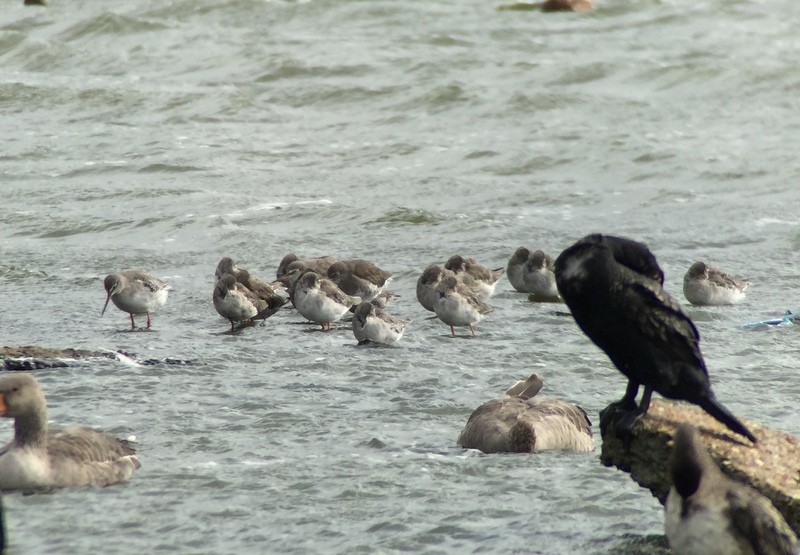 Spotted Redshanks – gathered in a huddle out in the middle
Spotted Redshanks – gathered in a huddle out in the middle
As well as all the waders, a young Great Crested Grebe and a couple of Little Grebes were diving out on the pit. As well as some of the more regular wildfowl, we found a small group of Wigeon. There are many more here in the winter, but these are some of the first birds which have returned from their breeding grounds in Russia. As with all the ducks at this time of year, the drakes are in eclipse plumage so are not looking their finest, but they were still nice to see.
As we walked back to the car, lines of waders were coming off the pit and flying over our heads, back out to the Wash. They seemed a little slow to return to the mud today, perhaps because their roost sites were nicely sheltered from the wind. On one of the northern pits, we stopped to look through a raft of gulls out on the water. Most were Black-headed Gulls, but in with them we found a few Mediterranean Gulls too. All adults in winter plumage now, we admired their white wingtips and black bandit masks.
 Mediterranean Gull – a few were on the pits today
Mediterranean Gull – a few were on the pits today
We planned to spend the rest of the day at Titchwell. A Blackcap appeared in the elder above the car as we arrived in the overflow car park. It grabbed a berry and disappeared back down into cover. There was too much disturbance now, so not much else in the bushes here today. The feeders by the visitor centre were busier, with a selection of finches and tits.
There was a bit of time before lunch still, so we decided to explore the Fen and Autumn Trails first. Stopping at Patsy’s reedbed, we could see a couple of Little Grebes diving in the water and lots of Mallard and Gadwall asleep on the islands. A Snipe appeared at the water’s edge just along from the screen, before creeping back into the vegetation. Further along, a lone small duck was the Garganey. Through the scope, we could see its boldly marked face pattern.
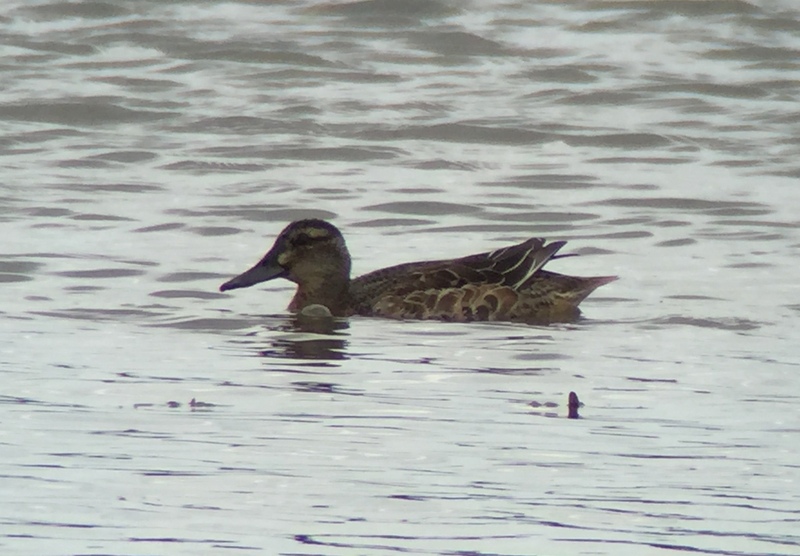 Garganey – on Patsy’s Reedbed
Garganey – on Patsy’s Reedbed
Walking along the Autumn Trail, a flock of Golden Plover flew in overhead from inland and dropped down towards the freshmarsh. They were nervous and seemed reluctant to settle, flying up again and whirling round several times. Round at the back of the freshmarsh, we could see a line of seven Spotted Redshanks and two Greenshanks in their usual favoured spot over by the fence but no sign of any Spoonbills here today. An adult and juvenile Ruff feeding down on the mud in the corner gave us a nice opportunity to compare them. Another Snipe was feeding quietly on the edge of the reeds.
We made our way back to the car for lunch, coming across several Bloody-nosed Beetles on the path as we did so. We could hear Long-tailed Tits calling from the sallows as we walked along the boardwalk. At the corner of the Meadow Trail, we stopped to watch a Migrant Hawker hovering over the small pool and a couple of Reed Warblers appeared in the cut vegetation at the back. A Chiffchaff flitted around in the bushes above the path.
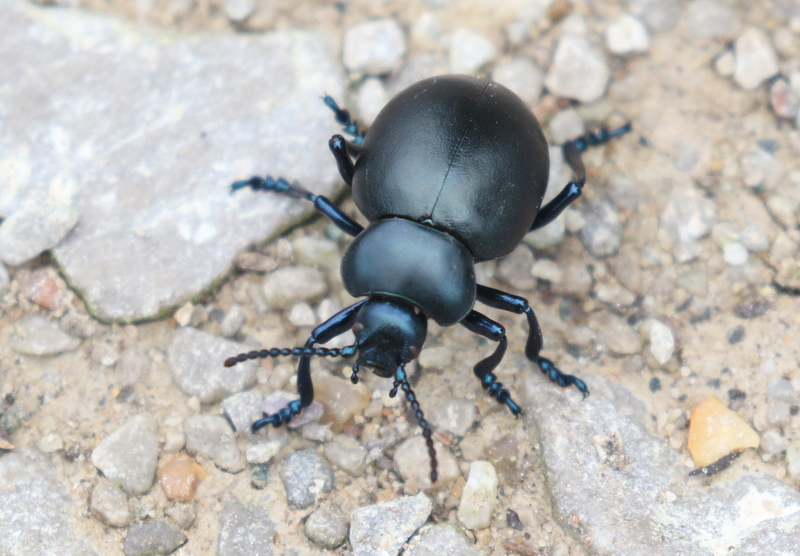 Bloody-nosed Beetle – we came across several walking along the paths
Bloody-nosed Beetle – we came across several walking along the paths
After lunch, we set out to explore the main part of the reserve. The grazing meadow ‘pool’ was largely empty of birds. Not part of the reserve, it is now in a sorry state, sadly mismanaged by the landowner. A little further along, we could see a crowd gathered. Two Mute Swans were blocking the path between them and us, and as we got nearer we could see why – three juvenile swans were resting on the top of the bank. Not a great place to choose!
 Mute Swans – these two were blocking the main path
Mute Swans – these two were blocking the main path
The male Mute Swan in particular was being very aggressive and people were reluctant to approach, which was leading to a traffic jam on the path. With some careful manoeuvring, we were able to persuade the two adult swans to climb onto the bank too and traffic could flow freely again.
A quick look at the reedbed pool produced a few Gadwall and Tufted Duck. Then scanning the saltmarsh the other side, we picked up a large white bird flying up from one of the channels towards Thornham. It was a Spoonbill and it flew round and headed in our direction, eventually passing over Island Hide just ahead of us, before disappearing over the back of the freshmarsh and dropping down beyond the far bank.
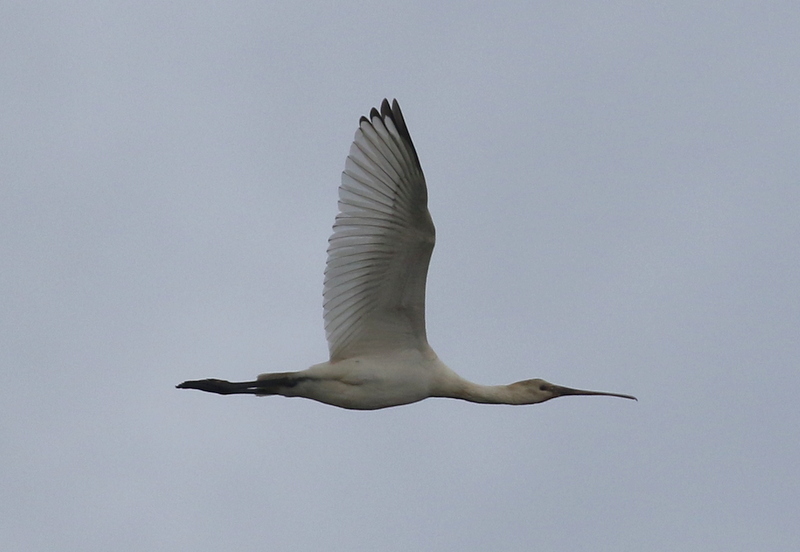 Spoonbill – flew in from Thornham and across the freshmarsh
Spoonbill – flew in from Thornham and across the freshmarsh
From Island Hide, we could see lots of waders out on the mud. Several Avocets were feeding in front of the hide, sweeping their bills back and forth through the shallow water. There were more Ruff round this side of the freshmarsh too. A flock of smaller waders over in the corner by the main path was mostly Dunlin. But a careful scan through revealed two Little Stints and two juvenile Curlew Sandpipers.
A third Little Stint was out on one of the muddy islands in the middle and while we were watching it running around it suddenly froze and crouched low to the mud. At the same time, all the other waders suddenly too to the air. Looking up, a Hobby was flying over. It circled over the freshmarsh before turning sharply and stooping into a flock of waders. It didn’t catch anything, but circled up again and then swooped down over the reedbed.
 Hobby – chasing waders around the freshmarsh
Hobby – chasing waders around the freshmarsh
Once the Hobby had disappeared the smaller waders resettled in a group further over. This time, we could see three Curlew Sandpipers now and one of them was an adult moulting out of summer plumage. Through the scope, we could see its botchy orange underparts. The smaller waders gradually returned to the corner where they had been feeding, and from up on the main path we had great views of the Dunlin and Little Stints out on the mud. Several Ruff walked back to the muddy edge along the reeds just below us.
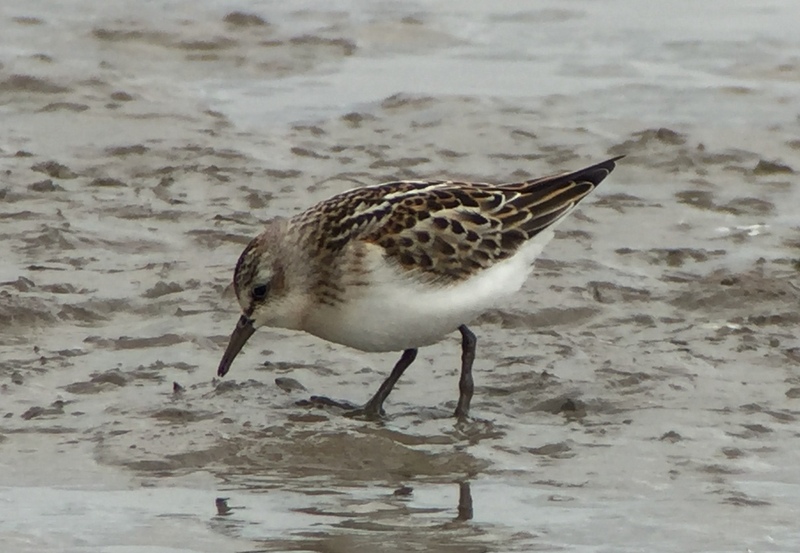 Little Stint – feeding on the mud by the main path
Little Stint – feeding on the mud by the main path
Round at Parrinder Hide, there were several Black-tailed Godwits feeding in front of the hide. Most of them are now largely in grey-brown winter plumage, but one was still mostly in much brighter summer plumage, with rusty head and breast and black-barred belly.
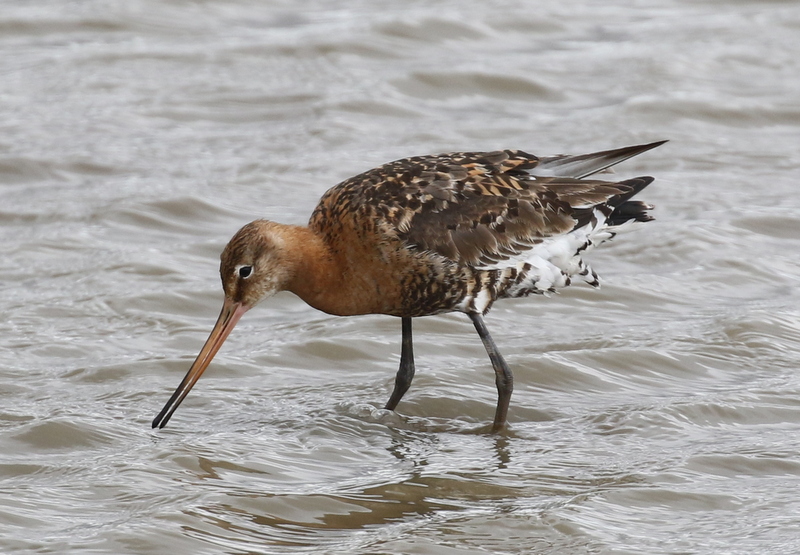 Black-tailed Godwit – this one was still mostly in summer plumage
Black-tailed Godwit – this one was still mostly in summer plumage
A Shoveler was also feeding just below the hide, head down, shoveling through the muddy water. It was great to watch it feeding up close.
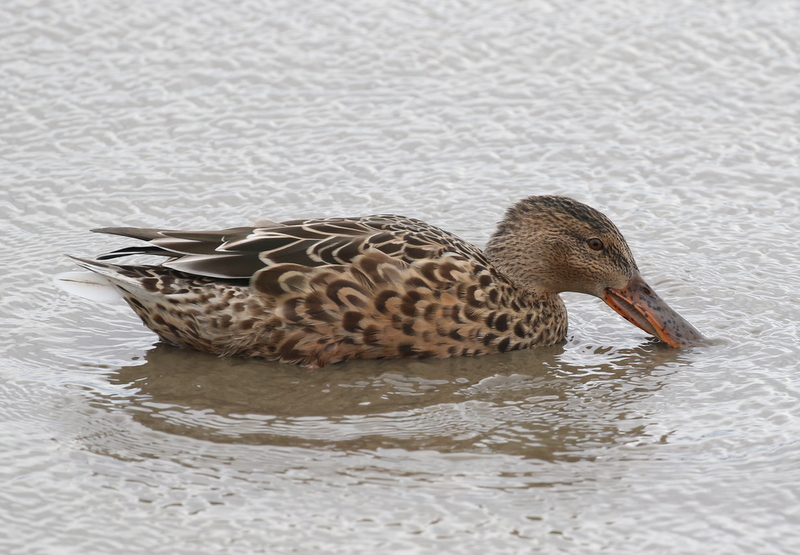 Shoveler – shoveling through the muddy water
Shoveler – shoveling through the muddy water
Round on the other side of Parrinder Hide, overlooking the Volunteer Marsh, there were a lot fewer birds but we did get nice views of both Avocet and Curlew feeding close to us. Through the scope, we admired the intricately patterned plumage of the latter.
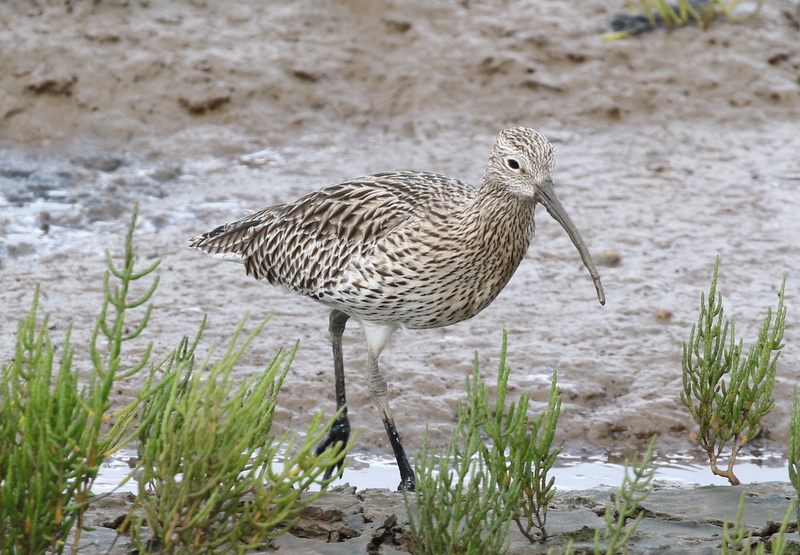 Curlew – feeding on Volunteer Marsh
Curlew – feeding on Volunteer Marsh
In a brighter interlude, we walked out to the beach. The wind had dropped a little this afternoon, and thankfully it wasn’t as blustery now. A couple of Bar-tailed Godwits were feeding on the beach and a very smart summer plumage Grey Plover was down on the mussel beds. We could hear a Whimbrel calling and eventually spotted it out on the sand.
The sea was choppy. Out in the distance, we could see several Gannets circling and one flew past a little closer in. A little group of Common Terns was diving into the water just offshore and a Sandwich Tern flew past through the breakers, though more terns were feeding further out. We watched as a small party of Teal flew in over the sea, presumably freshly arrived from the continent for the winter, migration in action.
Then it was time to head back. A single Wheatear on the short grass behind the dunes provided a nice way to round off the day and the weekend.
















